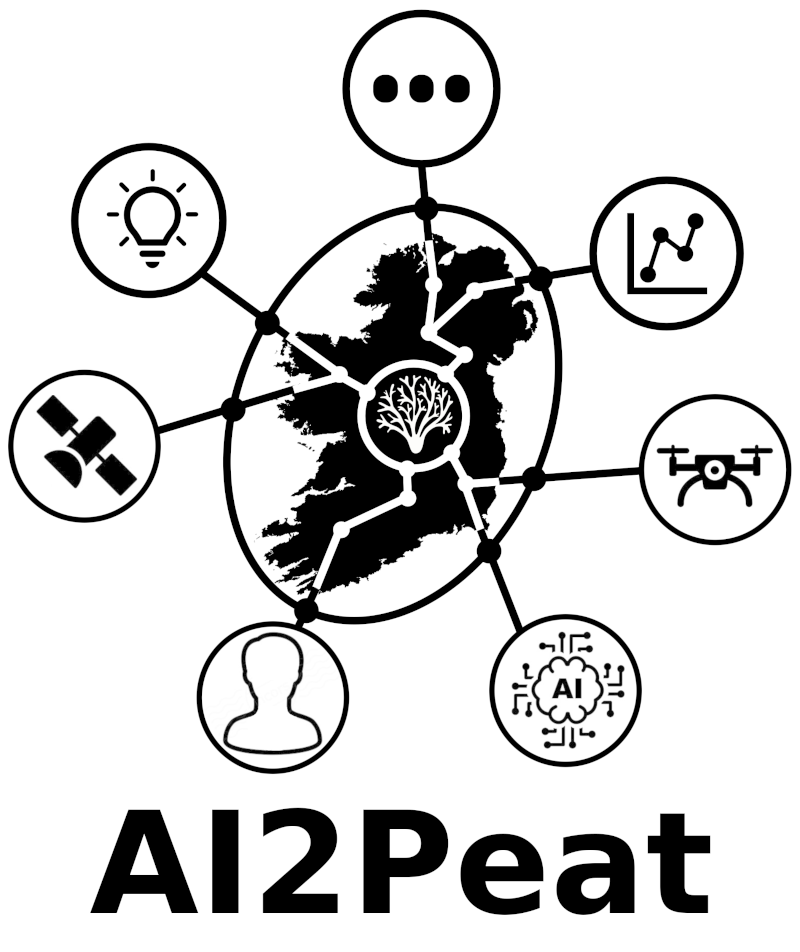Introduction
AI2Peat is a project funded by Science Foundation Ireland under its Future Digital Challenge call. It started on 1st January 2023 and is initially funded for 18 months. The project is divided in 2 phases: a CONCEPT phase (first 6 months) and a SEED phase (remaining 12 months). The AI2Peat consortium is composed of CeADAR – Ireland’s centre for applied AI -, iCRAG – the SFI centre for applied geosciences – and NPWS – Ireland’s National Parks and Wildlife Services. Check the Team page to meet the AI2Peat team!
Our project at a glance
Over 20% of Ireland is covered by peatland, which is a critical store of carbon as well as supporting rich and highly biodiverse ecosystems. Whilst these have developed over thousands of years, in only the last couple of centuries they have experienced accelerated deterioration from a range of human impacts. Thankfully, there is now a renewed interest in preserving and restoring these landscapes. As peatlands are central to Ireland’s Climate Action goals, there is an urgent need for accurate, nationwide monitoring over time.
The problem to be addressed really is reducing CO2 emissions from degraded peatlands by “rewetting” them, which is the majority. We need to know where this is possible, and how feasible that is. We lack the condition of that peatland at the habitat scale. A national peatland “condition” map will help this. So if this project can do that, NPWS and others can better identify areas to manage and restore, and develop CO2 emission factors associated with that etc. etc.
Dr. Shane Regan (NPWS), AI2Peat’s Societal Impact Champion
Our project will leverage Artificial Intelligence (AI) along with domain expert knowledge from the field to assess and continually monitor Ireland’s peatlands in a structured manner. Currently, the extent of Irish peatlands and their inaccessibility have hampered efforts to map their health on a large scale. However, AI provides the opportunity to augment the efforts of human experts, through the use of complementary data sources (e.g. satellite imagery) combined with in-situ measurements, as well as optimally guiding the efforts of data collection on the ground.
By engaging with a numerous and diverse variety of stakeholders we identified two key findings:
- We still don’t have a unique, unambiguous and detailed map/knowledge about the extent and condition of peatland in Ireland. This is essential for:
- reporting as part of the Habitats Directive (Article 17 Report)
- updating Ireland’s Climate Action plan
- identifying “low-effort, high-gain” areas to focus restoration/conservation activities
- fostering and supporting restoration financing schemes
- Collaboration, sharing and communication amongst all stakeholders is fundamental as:
- knowing “who does what” helps in e.g. linking researchers with local communities
- share and combine knowledge/data, in order to build consensus and ensure continuity after individual peatland restoration projects and other initiatives conclude
- communication across different stakeholder categories, e.g. be
- tween policy makers and local communities, should be simplified
- reducing the cost, effort and improving the efficacy of in-situ measurements, which are vital for all aspects of peatland monitoring
We therefore concluded AI2Peat should deliver an All-Ireland, AI-enhanced peatland conditioning map (hence the project name). This map will be built on top of a data and knowledge infrastructure which will facilitate networking activities among users/stakeholders. We will work on our solution by following the Agile and CI/CD software development principles.
We will continually update this website, allow early access to our PoC for beta testing and – why not – use. Stay tuned!

